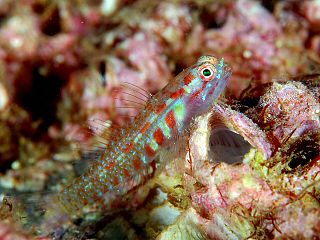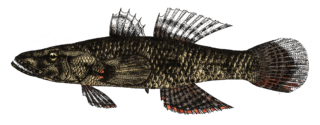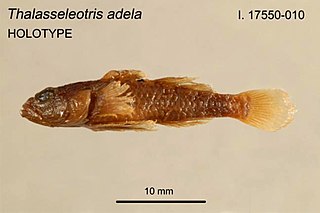
Eleotridae is a family of fish commonly known as sleeper gobies, with about 34 genera and 180 species. Most species are found in the tropical Indo-Pacific region, but there are also species in subtropical and temperate regions, warmer parts of the Americas and near the Atlantic coast in Africa. While many eleotrids pass through a planktonic stage in the sea and some spend their entire lives in the sea; as adults, the majority live in freshwater streams and brackish water. One of its genera, Caecieleotris, is troglobitic. They are especially important as predators in the freshwater stream ecosystems on oceanic islands such as New Zealand and Hawaii that otherwise lack the predatory fish families typical of nearby continents, such as catfish. Anatomically, they are similar to the gobies (Gobiidae), though unlike the majority of gobies, they do not have a pelvic sucker.

Graham's gudgeon, Grahamichthys radiata, is a species of goby of the family Thalasseleotrididae, the only member of the genus Grahamichthys. This species is found in rock pools and in the neritic zone, to 50 metres (160 ft) in depth, where sand or mud is lies around and partially buries rocks, shells, or other objects. It is unusual for a goby, in that it lives in loose schools.

Latridae commonly called trumpeters, is a family of marine ray-finned fish. They are found in temperate seas in the Southern Hemisphere. The classification of the species within the Latridae and the related Cheilodactylidae is unclear.They are fished commercially and for sport.

Eviota is a genus of fish in the family Gobiidae, commonly as dwarfgobies found in the Indo-Pacific region, where it is distributed from Japan to Australia and from Africa to Pitcairn Island. Species are mainly associated with coral reefs. Many of these fish are short-lived, with life cycles as brief as 3.5 weeks in the tropics. Some species are hermaphrodites and some representatives live symbiotically among the tentacles of the mushroom coral.
Milyeringa is a genus of blind cavefish from the Cape Range and Barrow Island, northwestern Australia. Although traditionally considered to belong to the family Eleotridae, studies show that they represent a distinct and far-separated lineage together with the Typhleotris cavefish from Madagascar, leading some to move them to their own family, Milyeringidae. The generic name is taken from Milyering which is 20 miles (32 km) southwest of Vlamingh Head in the North West Cape of Western Australia, the type locality for Milyeringa veritas.

The Gobiiformes are an order of fish that includes the gobies and their relatives. The order, which was previously considered a suborder of Perciformes, is made up of about 2,211 species that are divided between seven families. Phylogenetic relationships of the Gobiiformes have been elucidated using molecular data. Gobiiforms are primarily small species that live in marine water, but roughly 10% of these species inhabit fresh water. This order is composed chiefly of benthic or burrowing species; like many other benthic fishes, most gobiiforms do not have a gas bladder or any other means of controlling their buoyancy in water, so they must spend most of their time on or near the bottom. Gobiiformes means "goby-like".

The Gobionellinae are a subfamily of fish which was formerly classified in the family Gobiidae, the gobies, but the 5th Edition of Fishes of the World classifies the subfamily as part of the family Oxudercidae. Members of Gobionellinae mostly inhabit estuarine and freshwater habitats; the main exception is the genus Gnatholepis, which live with corals in marine environments. The subfamily is distributed in tropical and temperate regions around the world with the exception of the northeastern Atlantic Ocean, the Mediterranean Sea, and the Ponto-Caspian region. It includes around 370 species and 55 genera: Wikipedia articles about genera list about 389 species.
Elacatinus chancei, the shortstripe goby, is a species of ray-finned fish in the family Gobiidae. It lives inside or on the surface of a sponge and occurs in tropical waters in the west central Atlantic Ocean, the Bahamas, the Antilles, and Venezuela.
Paraxenisthmus springeri is a species of fish in the genus Paraxenisthmus of the Xenisthmidae (wriggler) family, which is regarded as a synonymous with the Eleotridae, from the West Pacific. Its specific name honours the American ichthyologist Victor G. Springer of the U.S. National Museum for his contributions to fish systematics.
Milyeringa justitia, commonly known as the Barrow cave gudgeon, is a species of fish in the family Milyeringidae endemic to groundwater systems (aquifers) of Barrow Island, around 50 km off the Pilbara coast in Western Australia. This troglobitic species has a pale body, lacking in pigment, and it is eyeless and blind, using sensory papillae located on the head and body to allow it to feed and move around in total darkness. The specific name justitia is Latin for "justice" and was given by the describers to complement the specific name of Milyeringa veritas which means "truth" in the hope that “As truth and justice are supposed to go together, we name this species justitia, from the Latin for justice, in the hope that justice helps the species to survive on Barrow Island, which has been an oilfield since 1967 and is most recently the site of the Gorgon Gas Hub development.” Very little is known about M. justitia as between 2002 and 2013 only six specimens were collected but its biology is assumed to be similar to that of M. veritas.

Butidae is a family of sleeper gobies in the order Gobiiformes. The family was formerly classified as a subfamily of the Eleotridae but the 5th Edition of Fishes of the World classifies it as a family in its own right. Molecular phylogenetic analyses have demonstrated that the Butidae are a sister clade to the clade containing the families Gobiidae and Gobionellidae and that the Eleotridae is a sister to both of these clades. This means that the Eloetridae as formerly classified was paraphyletic and that its subfamilies should be raised to the status of families.

Milyeringinae, the blind cave gobies, is a subfamily of gobies in the family Eleotridae. There are two genera and six species within the subfamily: one genus (Milyeringa) is restricted to caves in the North West Cape region of Australia and the other (Typhleotris) to underground water systems in Madagascar. They are all troglobitic species and have lost their eyes.
Belobranchus segura is a species of eleotrid sleeper goby which has been found in Indonesia on Halmahera, in Papua Barat and also on the Solomon Islands. It is an anadromous species in which the eggs are laid over rocky and gravel bottoms in freshwater streams. The free-swimming larvae then drift downstream to the sea where they undergo a planktonic stage before migrating up streams to mature and breed. It feeds on small crustaceans and fish. The specific name honours the French hydrobiologist Gilles Segura for his contribution to the study of fish faunas.

Thalasseleotris is a genus of gobies comprising two species in the family Thalasseleotrididae from the south-western Pacific Ocean in the seas off Australia and New Zealand. The generic name is derived from the Greek Thalassa meaning "sea" and the generic name Eleotris as at the time it was named the genus was considered to be in the family Eleotridae.

Oxudercidae is a family of gobies which consists of four subfamilies which were formerly classified under the family Gobiidae. The family is sometimes called the Gobionellidae, but Oxudercidae has priority. The species in this family have a cosmopolitan distribution in temperate and tropical areas and are found in marine and freshwater environments, typically in inshore, euryhaline areas with silt and sand substrates.

Goby is a common name for many species of small to medium sized ray-finned fish, normally with large heads and tapered bodies, which are found in marine, brackish and freshwater environments.
Knipowitschia caunosi, the Caunos goby or Köycegiz dwarf goby, is a species of ray-finned fish from the family Gobiidae which is endemic to Lake Köycegiz in western Anatolia near the Aegean Sea. The lake is protected and the species is abundant within the lake so the IUCN have classified K. caunosi as Least Concern. The specific name references the mythological figure Caunos, who was the twin sister of Byblis, in legend his sister fell in love with him and he fled to avoid committing incest, founding the ancient city Kaunos in Caria, the ruins of which are situated on the southwest Anatolian coast; near to Lake Köycegiz.
Oxyurichthys takagi is a species of goby is found in the Western Pacific: known only from Palau. This species reaches a length of 6.4 cm (2.5 in).

Wirz's goby is a species of goby found in Oceania from Papua New Guinea and northern Australia.

Oxuderces dentatus, is a species of goby found in the Indo-West Pacific from India to Vietnam, Macau, China, Malaysia and Indonesia.












